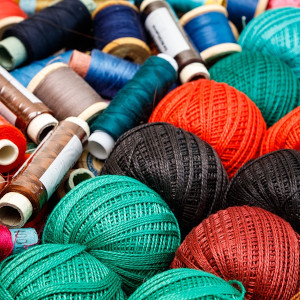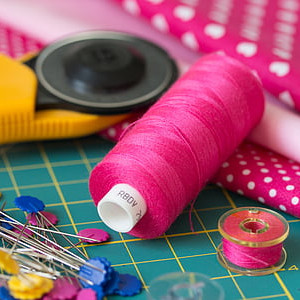 The concept of sewing does not just revolve around needle and thread. Although they both are the inevitable part, there are many other areas that one must concentrate on as a beginner. For an in-depth knowledge of sewing, the user must initially know how the sewing machine works and the different patterns of sewing. The technique of every stitching pattern is different from one another. But before that, it is also essential to know everything about threads sizes.
The concept of sewing does not just revolve around needle and thread. Although they both are the inevitable part, there are many other areas that one must concentrate on as a beginner. For an in-depth knowledge of sewing, the user must initially know how the sewing machine works and the different patterns of sewing. The technique of every stitching pattern is different from one another. But before that, it is also essential to know everything about threads sizes.
Threads are technologically modified so that they can pass through the sewing machine. For various stitching patterns, there is a requirement of a particular size of thread. The correct thread size results in the exact desired pattern. Incorrect thread size will lead to loss of valuable resources like time, labor, money, equipment, and, most importantly, the actual fabric. A damaged material cannot mend again, leading to the loss of the project. For achieving the best result in terms of quality and strength, it requires better knowledge about different thread sizes.
Picking the Correct Size of Thread
Choosing the right size of a thread can be a little difficult for beginners. The sewing thread sizes denote a specific numeric process. You must understand what do these numbers stand for.
There should not be any confusion between sewing thread sizes and sewing thread weights.
Both are different.
The numeric reflection about the thread sizes depends on weight and length.
Classification of Sewing Thread Sizes
 Two different numeric systems can classify the size of the sewing threads. It can divide into two parts. These are:
Two different numeric systems can classify the size of the sewing threads. It can divide into two parts. These are:
Direct Count System
As per this numeric system, the weight of a pre-decided length results in a direct count system. The factors depending on it are:
Denier
It is one of the standard techniques for determining thread size. The size denotes the weight (grams) of a 9000 meters length. Larger the denier size, more massive is the thread. For general stitching, 350 Denier thread is standard.
Tex
The size derives by the representation of weight (in grams) of 1000 meters of thread. In simple words, if a thread is 1000 meters long, and weighs 25 grams, the denotation is in the form of 25 TEX.
For converting TEX size to denier, you can multiply Tex number by 0.1111. Larger the Tex size, the heavier is the thread.
Indirect Count System
As per this numeric system, the thread size derives from another measuring system. The most common methods are as follows:
Metric Count
Here, the thread size follows assigning length to the weight of the thread. Higher metric count means thinner strands, and ones with lower metric counts are thicker. If metric count is 50 or more, the thread is more delicate, and if the metric count is between 10 to 15, threads are not hard in nature.
Cotton Count
Representation of metric cotton count on the thread is NEC, NeB, or Ne. Another kind of complicated count system is the cotton count. It is one of the ancient measuring units of sewing thread sizes. Here, measurement depends on every single strand of size as, in general, multiple strands collectively form a thread. The origin of this count system was from the cotton industry, which dates back in time. More delicate threads have a count between 120 to 160. Similarly, the ones in between 22 and 34 are thicker.
 Hong Kong Count
Hong Kong Count
Another measuring unit similar to cotton count is the Hong Kong count system. However, there is no use of a slash here. Thus, to make things clear, if the cotton count of a thread is 502/2, then the representation in the latter form is 502 Hong Kong Ticket.
Industry Sizes
They derive by dividing thread size as per denier by 10. Threads of size 10V and 18V are intricate, whereas the ones between 63V and 90V are not fine. Commonly, 35V thread size is the requirement for everyday stitching.
Gunz Count System
Japan was the first to establish this system for determining thread sizes but is most common for thin threads. Its representation is # 50 or No. 50. An important tip here is, there should not be any confusion about the Gunz Count system with the weight count of any thread. A thread of 70 metric counts is not similar to No. 70. Both are different threads.
Applications Of Various Threads As Per Their Sizes
The uses of each thread size are different from one another. Few applications are as follows:
- Rayon and Polyester threads of size 120/2 have applications in embroidery.
- For industrial use, threads are as per Tex size.
- For blind and handloom stitching, T-15 and T-20 are usable.
- Thicker threads of sizes T-70 and T-100 are applicable while topstitching and buttonholes.
- In fabrics with dense stitches, use thread with the lower metric count.
- In light sewing, thread size between 602 and 1203 Hong Kong Ticket is useful.
- In the case of upholstery, canvas, and other furniture manufacturing, it is advisable to use commercial thread sizes as these are heavy-duty threads.
The Usefulness Of Thread Size
Every sewing project differs when it comes to general sewing or heavy sewing. For each, the correct thread size is essential. A wrong size than damage the whole project and also will not be able to handle the longevity of the finished product. The importance of choosing the correct size of thread while sewing are as follows:
- The correct thread size enhances quality.
- A wrong thread size may cause blockage in the sewing machine.
- Correct thread size will ensure the required tension as per the fabric.
- Proper thread and needle size prevent skipping stitches and fraying of the fabric.
- It also performs well and avoids breakage amid a project.
Sewing Thread Sizes: Important Tips
- While changing the thread size also adjusts the tension of the sewing machine.
- Threads are available in various forms like- cones, vicones, spools, etc.
- Use the correct thread size along with is denotation.
- For the perfect thread size, use the correct naming system while purchasing.
- Use a standardized sizing system for all threads to avoid confusion.
- Use metric count for general projects.
Thus, it is essential to select the correct thread size for a particular project so that the final product is durable and sturdy, along with the enhancement of the overall look.


